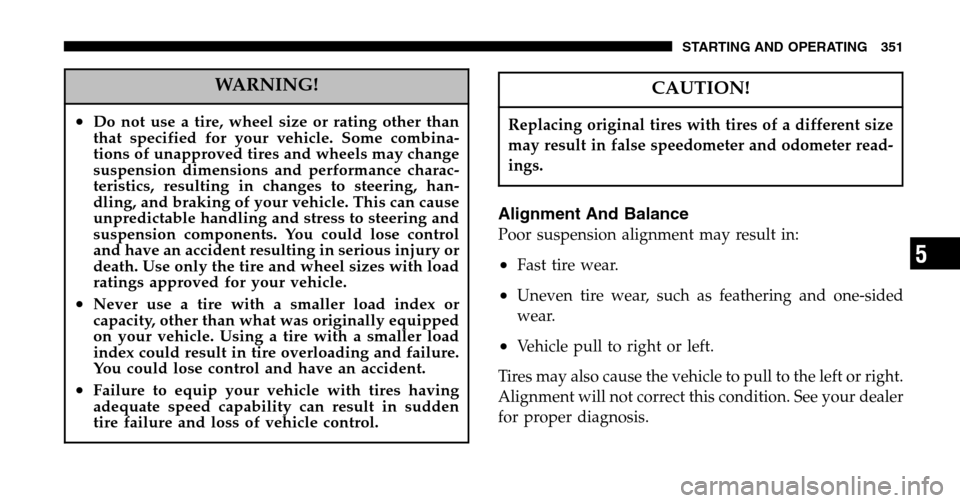2006 DODGE RAM 1500 GAS tire size
[x] Cancel search: tire sizePage 351 of 536

WARNING!
•Do not use a tire, wheel size or rating other than
that specified for your vehicle. Some combina-
tions of unapproved tires and wheels may change
suspension dimensions and performance charac-
teristics, resulting in changes to steering, han-
dling, and braking of your vehicle. This can cause
unpredictable handling and stress to steering and
suspension components. You could lose control
and have an accident resulting in serious injury or
death. Use only the tire and wheel sizes with load
ratings approved for your vehicle.
•Never use a tire with a smaller load index or
capacity, other than what was originally equipped
on your vehicle. Using a tire with a smaller load
index could result in tire overloading and failure.
You could lose control and have an accident.
•Failure to equip your vehicle with tires having
adequate speed capability can result in sudden
tire failure and loss of vehicle control.
CAUTION!
Replacing original tires with tires of a different size
may result in false speedometer and odometer read-
ings.
Alignment And Balance
Poor suspension alignment may result in:
•Fast tire wear.
•Uneven tire wear, such as feathering and one-sided
wear.
•Vehicle pull to right or left.
Tires may also cause the vehicle to pull to the left or right.
Alignment will not correct this condition. See your dealer
for proper diagnosis.
STARTING AND OPERATING 351
5
Page 352 of 536

Improper alignment will not cause vehicle vibration.
Vibration may be a result of tire and wheel out-of-
balance. Proper balancing will reduce vibration and
avoid tire cupping and spotty wear.
SUPPLEMENTAL TIRE PRESSURE INFORMATION
– IF EQUIPPED
A light load vehicle condition is defined as two passen-
gers {150 lbs (68 kg) each} plus 200 lbs (91kg) of cargo.
Cold tire inflation pressures for a lightly loaded vehicle
will be found on the face of the driver’s door.
TIRE CHAINS
Use “Class S” chains on 1500 Ram Trucks, or other
traction aids that meet SAE Type “S” specifications.
Use “Class U” chains on 2500/3500 Ram Trucks, or other
traction aids that meet SAE Type “U” specifications.
NOTE: Chains must be the proper size for the vehicle,
as recommended by the chain manufacturer.
CAUTION!
To avoid damage to your vehicle, tires or chains, observe the
following precautions:
•Because of limited chain clearance between tires and other
suspension components, it is important that only chains in
good condition are used. Broken chains can cause serious
vehicle damage. Stop the vehicle immediately if noise
occurs that could suggest chain breakage. Remove the
damaged parts of the chain before further use.
•Install chains as tightly as possible and then retighten
after driving about 1/2 mile (0.8 km).
•Do not exceed 45 mph (72 km/h).
•Drive cautiously and avoid severe turns and large bumps,
especially with a loaded vehicle.
•Do not install tire chains on front wheels of 4x2 vehicles.
•Do not drive for a prolonged period on dry pavement.
•Observe the tire chain manufacturer’s instructions on
method of installation, operating speed, and conditions for
usage. Always use the lower suggested operating speed of
the chain manufacturer if different than the speed recom-
mended by the manufacturer.
352 STARTING AND OPERATING
Page 353 of 536

These cautions apply to all chain traction devices, includ-
ing link and cable (radial) chains.
Tire chain use is permitted only on the rear tires of Ram
4X2 trucks.
NOTE: The use of class “S” chains is permitted on 1500
Ram Trucks with P245/70R17 tires only.
NOTE: The use of class “U” chains is permitted on the
front and rear of 4X4, 2500 Ram Trucks with LT245/
70R17E tires.
NOTE: The use of class “U” chains is permitted on the
front and rear of 4X4, 3500 Ram Trucks with Dual Rear
Wheels and LT235/80R17E tires.
NOTE: On 4X2 2500/3500 Ram Trucks, class “U” snow
chains are permitted on the rear wheels only of vehicles
equipped with LT245/70R17, LT265/70R17, and LT235/
80R17 size tires. NOTE:
On 4x4 2500/3500 SRW (Single Rear Wheel)
Ram Trucks, class “U” snow chains are permitted on the
rear wheels only of vehicles equipped with LT265/
70R17E.
CAUTION!
Do not use tire chains on 4x4 Ram trucks equipped
with P265/70R17, LT275/70R17, P275/60R20, tires.
There may not be adequate clearance for the chains
and you are risking structural or body damage to
your vehicle. Do not use tire chains on the 4X2 front
wheels of 2500/3500 SRW (Single Rear Wheels)
equipped with LT245/70R17, LT265/70R17 LT235/
80R17 tires or 4X4 front wheels of Ram Trucks
equipped with LT265/70R17E. There may not be
adequate clearance for the chains and you are risking
structural or body damage to your vehicle.
STARTING AND OPERATING 353
5
Page 354 of 536

SNOW TIRES
Snow tires should be of the same size and type construc-
tion as the front tires. Consult the manufacturer of the
snow tire to determine any maximum vehicle speed
requirement associated with the tire. These tires should
always be operated at the vehicle maximum capacity
inflation pressures under any load condition.
While studded tires improve performance on ice, skid
and traction capability on wet or dry surfaces may be
poorer than that of non-studded tires. Some states pro-
hibit studded tires; therefore, local laws should be
checked before using these tire types.
TIRE ROTATION RECOMMENDATIONS
Tires on the front and rear axles of vehicles operate at
different loads and perform different steering, driving,
and braking functions. For these reasons, they wear at
unequal rates, and develop irregular wear patterns.
These effects can be reduced by timely rotation of tires.
The benefits of rotation are especially worthwhile with
aggressive tread designs such as those on On/Off Road
type tires. Rotation will increase tread life, help to main-
tain mud, snow, and wet traction levels, and contribute to
a smooth, quiet ride.
Follow the recommended tire rotation frequency for your
type of driving found in the “Maintenance Schedules”
Section of this manual. More frequent rotation is permis-
sible if desired. The reasons for any rapid or unusual
wear should be corrected prior to rotation being per-
formed.
354 STARTING AND OPERATING
Page 368 of 536

Tire Size
The tire size on the Label represents the actual tire size on
your vehicle. Replacement tires must be equal to the load
capacity of this tire size.
Rim Size
This is the rim size that is appropriate for the tire size
listed.
Inflation Pressure
This is the cold tire inflation pressure for your vehicle for
all loading conditions up to full GAWR.
Curb Weight
The curb weight of a vehicle is defined as the total weight
of the vehicle with all fluids, including vehicle fuel, at full
capacity conditions, and with no occupants or cargo
loaded into the vehicle. The front and rear curb weight
values are determined by weighing your vehicle on a
commercial scale before any occupants or cargo are
added.
Loading
The actual total weight and the weight of the front and
rear of your vehicle at the ground can best be determined
by weighing it when it is loaded and ready for operation.
The entire vehicle should first be weighed on a commer-
cial scale to insure that the GVWR has not been exceeded.
The weight on the front and rear of the vehicle should
then be determined separately to be sure that the load is
properly distributed over front and rear axle. Weighing
the vehicle may show that the GAWR of either the front
or rear axles has been exceeded but the total load is
within the specified GVWR. If so, weight must be shifted
from front to rear or rear to front as appropriate until the
specified weight limitations are met. Store the heavier
items down low and be sure that the weight is distributed
equally. Stow all loose items securely before driving.
368 STARTING AND OPERATING
Page 415 of 536

wheel. The nuts should then be tightened to recom-
mended torque. Tighten the nuts to final torque in
increments. Progress around the bolt circle, tightening
the nut opposite to the nut just previously tightened until
final torque is achieved. Recommended torques are
shown in the following chart.
Disc
Wheels Type Nut Stud Size Torque
Ft. Lbs. Torque
Newton
Meters
Cone 9/16-18 120-150 160-200
Flanged 9/16-18 130-160 190-220
To Stow The Flat Or Spare
NOTE: 1500 Standard and Quad Cab vehicles
equipped with aluminum wheels cannot be stored under
the vehicle because the wheel retainer will not fit through
the wheel pilot hole. Secure the (flat) tire in the bed of the
truck, have the (flat) tire repaired or replaced immedi-
ately.
WARNING!
A loose tire thrown forward in a collision or hard
stop could injure the occupants in the vehicle. Have
the deflated (flat) tire repaired or replaced immedi-
ately.
Turn the wheel so that the valve stem is down. Slide the
wheel retainer through the center of the wheel and
position it properly across the wheel opening.
For convenience in checking the spare tire inflation, stow
with the valve stem toward the rear of the vehicle.
Attach the wheel wrench to the extension tube. Rotate the
winch mechanism until the wheel is drawn into place
against the underside of the vehicle. Continue to rotate
until you feel the winch mechanism slip or click 3 or 4
times. It cannot be overtightened. Push against the tire
several times to be sure it is firmly in place.
WHAT TO DO IN EMERGENCIES 415
6
Page 532 of 536

Radial.............................. 346
Replacement ......................... 350
Rotation ............................. 354
Safety ........................... 335,343
Sizes ............................... 336
Snow Tires ........................... 354
Spare Tire ........................... 404
Spinning ............................ 348
Tread Wear Indicators ................... 349
Wheel Mounting ....................... 405
Wheel Nut Torque ..................... 410
Tongue Weight/Trailer Weight .............. 373
Torque Converter Clutch .................. 304
Tow Hooks, Emergency ................... 420
Towing ............................... 370
Disabled Vehicle ....................... 420
Guide .............................. 373
Recreational .......................... 387
Weight .............................. 373 Traction
.............................. 395
Trailer Towing .......................... 370
Cooling System Tips .................... 380
Hitches ............................. 372
Minimum Requirements ................. 375
Mirrors ........................... 1 19,381
Trailer and Tongue Weight ................ 373
Wiring .............................. 378
Trailer Towing Guide ..................... 373
Trailer Weight .......................... 373
Transfer Case ........................... 453
Electronically Shifted ................. 312,320
Fluid ............................... 486
Transmission Automatic ........................ 299,454
Fluid ............................... 486
Maintenance ....................... 453,454
Manual ..................... 296,304,306,453
Shifting .......................... 299,307
532 INDEX